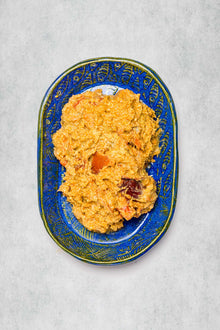Fresh Hand-Picked Brown Crab Meat 125g

Serves 1 - 125g
£4.95
Modern living is all about speed. Fast food. Instant messaging. Next day delivery. We all want things to be fast. And with the dawn of the AI revolution this is even more evident. But when it comes to food, it’s often better to take things slowly.
The global movement focused on promoting good, clean and fair food? The very same. Unlike ‘fast’ food, which is often hyper-globalised, ultra-processed and produced to maximize profits over sustainability, ‘slow food’ is all about championing food that is environmentally friendly, good for us and good for the local people who produced it.
Crabs.
Crab eating is an adventure. But it’s not something you can rush. Literally. Crabs are very often served whole, in their shell, meaning unlike a bucket of chlorinated chicken wings, you can’t just inhale them like you’re a Dyson cordless vacuum. Crab eating requires work, skill - even, to prize open the precious meat hidden in their thick, and - we’ll admit - fiddly shells. If anything, good crab picking is an art form – and one that’s quickly dying out.
Not when it comes to crabs. For millennia crab eating has been at the backbone of civilisation in the British Isles. Archaeological sites are forever uncovering the traces of neolithic settlers hosting crab parties, with splinters of shell scattered around primitive eating spaces. I imagine a cold and stormy night in the mud hut could become quite a joy with crab picking demonstrations by the hearth light. With flint chisels, and hammerstones you can picture it becoming some sort of stone age version of MasterChef!
Sure. But the fact is today, the BBC are saying that there’s such a shortage of crab pickers in this country that many seafood companies are being forced to send their British-caught crab to Vietnam just to be picked!
Well even in our domestic lives it’s an issue. I mean really, who’s picking and eating a crab in their home anymore, mud hut or otherwise? In fact, crab eating is such a novelty in this country that 95% of all the Spider Crabs caught here are exported to be eaten abroad. It’s total insanity, especially when you consider that the UK has some of the world’s most abundant stocks - 60% of the global volume of Brown Crabs are caught here, and yet the closest any of us get to one of these sumptuous crustaceans is a crab stick which in actual fact are made of pollack.
For starters crabs are caught with pots. Long ropes of baited cages where the crabs are lured inside. Importantly, being inside a crab pot does little harm to a crab – which means undersized crabs can be returned to the ocean unscathed.
Further, our system of crab sizing is tightly managed. A fisherman would be hard pressed to find a market for an undersized crab, and the risk they’d be taking with the law would be detrimental.
Finally, crab catching is very seasonal as the crabs come inshore for spring and summer. The crabs we buy are caught never more than 6 miles from our Brixham HQ.
That’s true. I just thought it would be implied. I mean, it’s pure wild protein that you steam and extract out of a shell. No saturated fats, processed oils, weird emulsifiers or chemicals. It’s just natural goodness, like long-chain Omega 3 fatty acids. Specifically, EPA and DHA, which help lower blood pressure, protect against heart disease, improve cognitive function, and reduce conditions like psoriasis and ulcerative colitis.
Meanwhile, the minerals in crab – copper, zinc, selenium – are rocket fuel for your immune system.
So yes, if you’re wondering “Is eating crab good or bad for you?” — it’s very, very good.
That’s more like it. Well, getting a crab is step one. Step two is not being shy. With a hammer and the handle of a cheap teaspoon (provided it’s a pointy-ish handle), you can pick yourself a meal’s-worth easily. No fancy new tools required!
Top tips:
• Learn to tell the brown meat from the white meat.
• Brown is rich, seaweedy, and creamy.
• White is more delicate and light.
• You can eat almost every part of the crab. Inside the carapace (or “head”, if you like), you’ll find the “dead man’s fingers”. Fish lovers find it fun to tease children and gullible guests that they’re poisonous — which, given their furry green appearance, is pretty believable. (Don’t eat them. They’re not dangerous, just not delicious either.)
Well, technically you can. Sort of. Once we’ve picked and poked all the sumptuous brown and white meat out of our crabs, we tend to roast the shells for about 10 minutes, and then boil them up with water, white wine, carrots, onions, bay leaves and celery - to make unbeatable shellfish stock.
It’s the perfect base for a luxurious bisque, a Tom Yum soup, or a seafood stew.
So where do I buy these crabs?
At Rockfish of course. All season long we’ll be sourcing the very finest catches from the world famous Brixham crab fishery to be sold online and in all our restaurants. Believe us, this will be the freshest crab money can buy. No pasteurised meat, and certainly nothing that’s been sent to Vietnam and back!
At Rockfish you can learn how to pick your own crabs, we’ve done the hard bit finding you the freshest and finest, all you have to do is get snuffling. We’ll even provide the hammer and bib!
But if working for your food really isn’t for you, try our new fresh crab salad – a combination of sweet, delicate meat from hand-picked Spider Crab with the rich, indulgent brown meat from Brown Crab. For those who want the flavour, with none of the fuss.